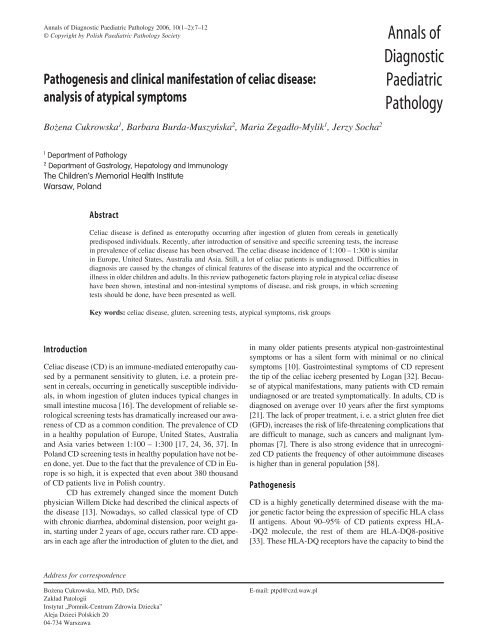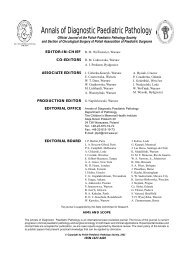annals 1-2.qxd - Centrum Zdrowia Dziecka
annals 1-2.qxd - Centrum Zdrowia Dziecka
annals 1-2.qxd - Centrum Zdrowia Dziecka
You also want an ePaper? Increase the reach of your titles
YUMPU automatically turns print PDFs into web optimized ePapers that Google loves.
Annals of Diagnostic Paediatric Pathology 2006, 10(1–2):7–12<br />
© Copyright by Polish Paediatric Pathology Society Annals of<br />
Pathogenesis and clinical manifestation of celiac disease:<br />
analysis of atypical symptoms<br />
Bo¿ena Cukrowska 1 , Barbara Burda-Muszyñska 2 , Maria Zegad³o-Mylik 1 , Jerzy Socha 2<br />
Diagnostic<br />
Paediatric<br />
Pathology<br />
1<br />
Department of Pathology<br />
2<br />
Department of Gastrology, Hepatology and Immunology<br />
The Children’s Memorial Health Institute<br />
Warsaw, Poland<br />
Abstract<br />
Celiac disease is defined as enteropathy occurring after ingestion of gluten from cereals in genetically<br />
predisposed individuals. Recently, after introduction of sensitive and specific screening tests, the increase<br />
in prevalence of celiac disease has been observed. The celiac disease incidence of 1:100 – 1:300 is similar<br />
in Europe, United States, Australia and Asia. Still, a lot of celiac patients is undiagnosed. Difficulties in<br />
diagnosis are caused by the changes of clinical features of the disease into atypical and the occurrence of<br />
illness in older children and adults. In this review pathogenetic factors playing role in atypical celiac disease<br />
have been shown, intestinal and non-intestinal symptoms of disease, and risk groups, in which screening<br />
tests should be done, have been presented as well.<br />
Key words: celiac disease, gluten, screening tests, atypical symptoms, risk groups<br />
Introduction<br />
Celiac disease (CD) is an immune-mediated enteropathy caused<br />
by a permanent sensitivity to gluten, i.e. a protein present<br />
in cereals, occurring in genetically susceptible individuals,<br />
in whom ingestion of gluten induces typical changes in<br />
small intestine mucosa [16]. The development of reliable serological<br />
screening tests has dramatically increased our awareness<br />
of CD as a common condition. The prevalence of CD<br />
in a healthy population of Europe, United States, Australia<br />
and Asia varies between 1:100 – 1:300 [17, 24, 36, 37]. In<br />
Poland CD screening tests in healthy population have not been<br />
done, yet. Due to the fact that the prevalence of CD in Europe<br />
is so high, it is expected that even about 380 thousand<br />
of CD patients live in Polish country.<br />
CD has extremely changed since the moment Dutch<br />
physician Willem Dicke had described the clinical aspects of<br />
the disease [13]. Nowadays, so called classical type of CD<br />
with chronic diarrhea, abdominal distension, poor weight gain,<br />
starting under 2 years of age, occurs rather rare. CD appears<br />
in each age after the introduction of gluten to the diet, and<br />
in many older patients presents atypical non-gastrointestinal<br />
symptoms or has a silent form with minimal or no clinical<br />
symptoms [10]. Gastrointestinal symptoms of CD represent<br />
the tip of the celiac iceberg presented by Logan [32]. Because<br />
of atypical manifestations, many patients with CD remain<br />
undiagnosed or are treated symptomatically. In adults, CD is<br />
diagnosed on average over 10 years after the first symptoms<br />
[21]. The lack of proper treatment, i. e. a strict gluten free diet<br />
(GFD), increases the risk of life-threatening complications that<br />
are difficult to manage, such as cancers and malignant lymphomas<br />
[7]. There is also strong evidence that in unrecognized<br />
CD patients the frequency of other autoimmune diseases<br />
is higher than in general population [58].<br />
Pathogenesis<br />
CD is a highly genetically determined disease with the major<br />
genetic factor being the expression of specific HLA class<br />
II antigens. About 90–95% of CD patients express HLA-<br />
-DQ2 molecule, the rest of them are HLA-DQ8-positive<br />
[33]. These HLA-DQ receptors have the capacity to bind the<br />
Address for correspondence<br />
Bo¿ena Cukrowska, MD, PhD, DrSc<br />
Zak³ad Patologii<br />
Instytut „Pomnik-<strong>Centrum</strong> <strong>Zdrowia</strong> <strong>Dziecka</strong>”<br />
Aleja Dzieci Polskich 20<br />
04-734 Warszawa<br />
E-mail: ptpd@czd.waw.pl

















